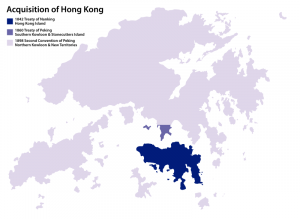Week 10: A Sense of Place
I. (Colonial) Society Reoriented—The MacLehose Years (1971–1982)
- Population (1981: > 5 millions) and economic growth
- Compulsory education (1971/1978)
- Expansion of public housing (1973–1983/40%)
- “New Towns” (“Small House Policy” [1972]; 240,000/2016; e.g., Shatin)
- Mei Foo Sun Chuen (const. 1968–78; 13,500 apartments)
- Official Languages Ordinance (1974)
- Independent Commission Against Corruption (1974; Peter Godber)
II. Identities Reimagined
- Hong Kong Festival (video; 1969, 1971, 1973)
- Diaoyu Islands (1970) . . . student movements
- Vietnamese Boat People (broadcast) (1975–2000; >230,000)
- Hong Kong Identification Card (1951, 1973, 1980)
- Cross-harbor Tunnel (1972); Mass Transit Railway (1975)
- City Magazine 號外 (founded 1976)
- Ah Chan (“The Good, The Bad, and the Ugly” 網中人 [1979]) . . . “Her Fatal Ways” 表姐,妳好嘢!(1990)
III. Pop Culture Manifested
- Music—Naam yam 南音 (e.g. Dou Wun 杜煥 [1910–79]) . . . Cantonese opera (e.g. Flower Princess 帝女花, 1957) . . . Romance of Jade Hall 璇宮艷史 (1957; The Merry Widow[1952]) . . . “The Fatal Irony” 啼笑姻緣 (1974; Sandra Lang 仙杜拉) . . . The Private Eyes (1976; Sam Hui 許冠傑; English version) . . . Anita Mui 梅艷芳 (1963–2003) . . . J-Pop . . . “Boundless Oceans, Vast Skies ” (1993; Japanese version) . . . My Little Airport
- Cinema
- Early history—Benjamin Brodsky (1877–1960) . . . Stealing the Roast Duck 偷燒鴨 (1909) . . . Lai Man-wai 黎民偉 (1893–1953) . . . China Sun Company 民新 (1922; Rouge 胭脂 [1924]) . . . United Photoplay Service 聯華 (1930–34) . . . Ng Cho-fan 吳楚帆 (1910–93) . . . Wong Man-lei 黃曼梨 (1913–98) . . . Platinum Dragon 白金龍 (1933; first “talking picture”) . . . Ma Sze-tsang 馬師曾 (1900–64) . . . Grandview Film Company 大觀 . . . ~7,000 films (to 1990)
- Post-war—Great China 大中華 . . . Union Film 中聯 (1952–67; In the Face of Demolition 危樓春曉 [1953]) . . . Great Wall 長城 . . . Phoenix 鳳凰 . . . Motion Picture & General Investment 電懋 (1956–71; The Greatest Wedding on Earth 南北一家親 [1962]). . . Shaw Brothers 邵氏 (1925)
- Transformations—production of Cantonese-language films (200/yr in early 1960s to 1 in 1971) . . . King Wu (Come Drink with Me 大醉俠 [1966]) . . . Bruce Lee (The Way of the Dragon 猛龍過江 [1972]). . . House of 72 Tenants 七十二家房客 (1973) . . . The Private Eyes 半斤八兩 (1975) . . . “New Wave”
- Radio/Television—Rediffusion 麗的呼聲 (1949; 1957 cable television) . . . Television Broadcasts (TVB; 1967) . . . The Fatal Irony 啼笑姻緣 (1974)
- Popular fiction—Jin Yong 金庸 . . . etc.
- Fast Food—McDonald’s (1975)
- Make a list of the contrasts drawn in the film Nomad (1982). What purposes do they serve, both cinematically and in terms of advancing the story?
- How should one make sense of the frequent references to Japan and Japanese culture in the film?
- Based on what you have read (and watched) for this course, how would you describe and explain this "new" sensibility that Nomad seems to embody? Is the usual "East meeting West" an adequate framework?
- In what ways is the notion of "hybridity" useful? In other words, what is there to gain by describing Hong Kong or the culture of Hong Kong as a "hybrid"? And what may be lost in doing so?
Top

